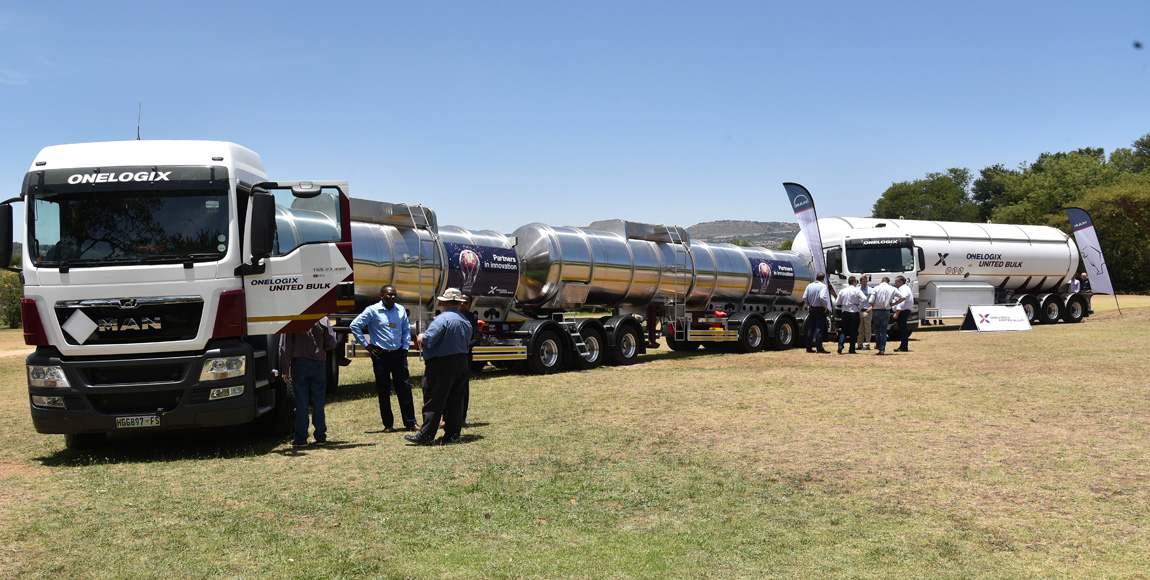Making history – one vehicle at a time

This week, One Logix and subsidiary United Bulk, together with MAN Automotive and tanker-trailer manufacturer CA Muller, unveiled the first-ever chemical-interlink tractor-trailer designed according to performance-based standards (PBS).
Ian Lowrance, CEO of One Logix, says: “It is only through changing the way we do things that value is created. The ‘can-do’ attitude of all parties involved has enabled us to seize an opportunity passed up by others.”
Pierre Scharneck, operations director of United Bulk, says that the new PBS tanker is the result of an application to tender submitted at the Sappi head office only six months ago. This is the latest of various special-configuration vehicles produced by United Bulk and CA Muller over the past few years.
“A project such as this requires specialist expertise and it is only through collaboration that we have achieved and, in fact, exceeded our own expectations. This trailer is a first of its kind and the future of such bulk transport,” asserts Scharneck.
The new tanker will be used to transport caustic lye, used in one of Sappi’s production processes, from the port of Richards Bay to Sappi’s processing plants in Umkomaas and Stanger, KwaZulu-Natal. Scharneck says: “Three vehicles of this specification can replace the work done by five standard combinations.”
A specialised MAN TGS 27.480 6×4 BBS – LX Cab XHD prime mover, pulling a dual tri-axle combination of trailers, was identified as the ideal combination. Dave van Graan, head of special projects at MAN Automotive, explains: “As standard, the XHD offers a gross combination mass (GCM) of 90 t. In its current form the combination has a legal GCM of 74 t, which translates to 52 t of payload.”
The XHD version differs from standard on-highway, long-haul vehicle types in that it uses uprated nine-tonne front and 26-t rear parabolic suspension. This provides a better angle of approach, greater ride height as well as resistance to ‘kneeling’ when the rig is braking, or when surge loads push weight from across the rig forwards onto the drive-axle unit.
All driveline components in the XHD are engineered for heavy-duty applications with additional hardening characteristics applied on all gear surfaces. “Whilst having the DNA of robust 33-t tractor heads, this unit is fitted with single-reduction hypoid axles that are more fuel efficient than hub-reduction alternatives,” adds Van Graan.
Christo Muller, founder and director of CA Muller, says: “Different fluids have different properties requiring the design of each tanker to be customised. For this project stainless steel was used and one will notice a slight two-degree ‘backward slant’ to the tankers.”
The angle acts as an aid when offloading and helps with positioning of the centre of gravity. At ground level, the positioning of the wheels and axles has an effect on the centre of gravity, as well as on weight distribution.
Muller explains that PBS replaces prescriptive parameters with performance-based grading. “Despite PBS vehicles being physically larger, fewer vehicles and less trips help to relieve congestion and minimise road damage.
“Even more important, however, is the 39-percent reduction in accidents that have been recorded since inception of the programme,” he adds.
Karl Opperman, CEO of Sappi, says: “Values that Sappi holds high include integrity, courage and smart decision-making that is executed safely with speed and efficiency. Just as the project saw the coming together of partners, it saw the coming together of these values through the delivery of this highly customised transport solution.”
Published by
Focus on Transport
focusmagsa




